This is an old revision of the document!
Table of Contents
Stroke Analysis
In this section an analysis of the kick drum mallet movement is performed using a high speed camera, a tiny Qt application and some basic vector math.
Two types of analysis are performed:
- A single hard kick drum stroke.
- A series of strokes at high tempo.
These two types of strokes are the result of very different playing styles and should cover the most basic uses of the kick drum in metal music.
The experiment was performed on an Axis Longboard pedal only, but should for good measure be performed on other types of pedals too.
A movie was made with 200fps and the 10-20 frames containing each of the two stroke types were subtracted. A couple of examples can be seen here (click to enlarge):
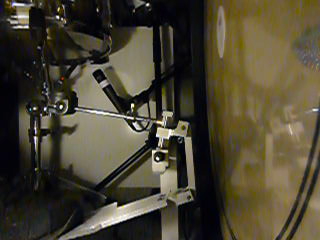
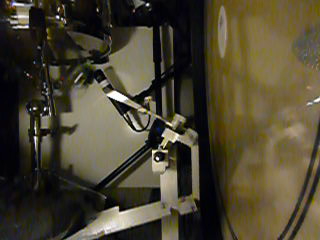
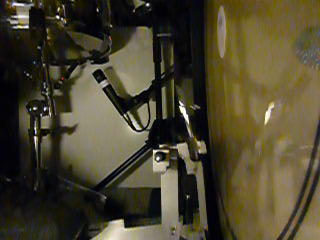
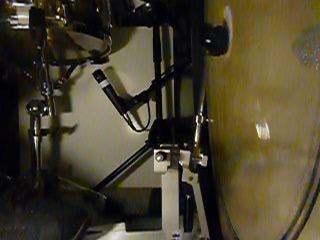
Note the white dots on the center-of-axis as well on the mallet. These were added in order to be able to identify their exact position in the frame.
Single stroke
| Position | Vector | Length | Angle | Angle diff | Angle speed |
|---|---|---|---|---|---|
| 0 | (-255,391) | 466.80px | 0.000000 | 0.000000 | 0.000000 dgr/s |
| 1 | (-247,394) | 465.02px | 1.027597 | 1.027597 | 205.519334 dgr/s |
| 2 | (-235,405) | 468.24px | 2.987024 | 1.959427 | 391.885459 dgr/s |
| 3 | (-210,420) | 469.57px | 6.546291 | 3.559267 | 711.853364 dgr/s |
| 4 | (-176,440) | 473.89px | 11.309932 | 4.763642 | 952.728338 dgr/s |
| 5 | (-134,458) | 477.20px | 16.803111 | 5.493178 | 1098.635630 dgr/s |
| 6 | ( -74,480) | 485.67px | 24.347241 | 7.544131 | 1508.826102 dgr/s |
| 7 | ( -6,491) | 491.04px | 32.411225 | 8.063984 | 1612.796717 dgr/s |
| 8 | ( 73,493) | 498.38px | 41.534099 | 9.122874 | 1824.574854 dgr/s |
| 9 | ( 146,480) | 501.71px | 50.029355 | 8.495256 | 1699.051165 dgr/s |
| 10 | ( 232,451) | 507.17px | 60.333194 | 10.303839 | 2060.767896 dgr/s |
| 11 | ( 240,446) | 506.47px | 61.396774 | 1.063580 | 212.715922 dgr/s |
| 12 | ( 229,452) | 506.70px | 59.979810 | -1.416964 | -283.392753 dgr/s |
A plot of the angle velocities reveal a rather 'jaggy' picture:
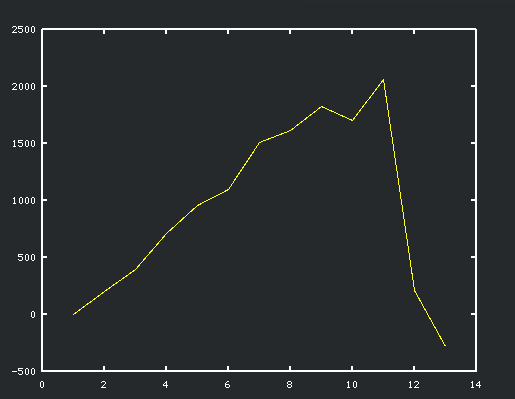
Stroke sequence
| Position | Vector | Length | Angle | Angle diff | Angle speed |
|---|---|---|---|---|---|
| 0 | (-381,215) | 437.48px | 0.000000 | 0.000000 | 0.000000 dgr/s |
| 1 | (-370,236) | 438.86px | 3.095041 | 3.095041 | 619.008128 dgr/s |
| 2 | (-356,267) | 445.00px | 7.433667 | 4.338626 | 867.725183 dgr/s |
| 3 | (-331,304) | 449.42px | 13.129037 | 5.695370 | 1139.074084 dgr/s |
| 4 | (-298,346) | 456.64px | 19.826380 | 6.697343 | 1339.468612 dgr/s |
| 5 | (-255,389) | 465.13px | 27.317846 | 7.491466 | 1498.293157 dgr/s |
| 6 | (-203,425) | 470.99px | 35.032433 | 7.714587 | 1542.917345 dgr/s |
| 7 | (-144,458) | 480.10px | 43.110075 | 8.077642 | 1615.528448 dgr/s |
| 8 | ( -78,483) | 489.26px | 51.390233 | 8.280159 | 1656.031738 dgr/s |
| 9 | ( -14,494) | 494.20px | 58.940436 | 7.550203 | 1510.040583 dgr/s |
| 10 | ( 54,496) | 498.93px | 66.777144 | 7.836708 | 1567.341558 dgr/s |
| 11 | ( 110,492) | 504.15px | 73.166538 | 6.389394 | 1277.878850 dgr/s |
| 12 | ( 162,483) | 509.44px | 79.105414 | 5.938875 | 1187.775047 dgr/s |
| 13 | ( 198,468) | 508.16px | 83.495869 | 4.390456 | 878.091137 dgr/s |
| 14 | ( 216,464) | 511.81px | 85.526559 | 2.030689 | 406.137879 dgr/s |
| 15 | ( 210,467) | 512.04px | 84.776208 | -0.750351 | -150.070120 dgr/s |
The graph of these angle velocities show a picture rather more 'smooth' than the one rendered from the single stroke:
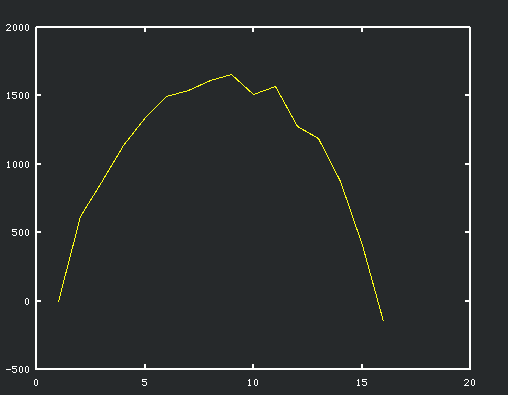
Conclusion
The maximum angle velocity was found in the single stroke and was 2061 degrees per second.
That the maximum angle velocity should be found in the stroke type is not surprising since a single stroke is the result of the hardest foot impact on the pedal.
If we assume the target latency to be at most 1ms and we assume that the software is responding in the area of microseconds we can estimate the target ADC resolution.
Lets start by pointing out that since the video framerate was 200fps each frame represent a state in 5ms intervals; ie. we are looking for something around at least 5 times more accurate.
The single stroke took 11 frames in total which is 55ms and duriong this time the mallet moved 61.4 degrees, resulting in a minimum resolution of 1.12 samplings per millisecond.
However, if we look at the diff in the last two velocities before the impact was 10.3 degrees in 5ms it is evident that the minimum resolution should be much higher, namely 2.06 samplings per millisecond.
Earlier studies performed with a shaft encoder showed that approximately 600 sampling points during the 61.4 degrees we sufficient, resulting in a upper-bound resolution of 92 sampling per millisecond.
